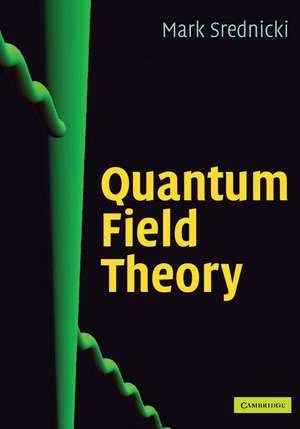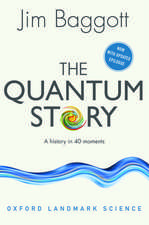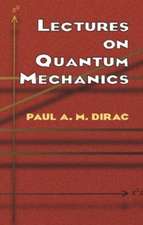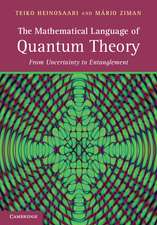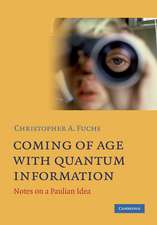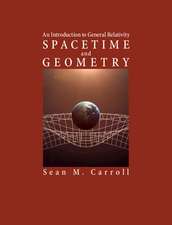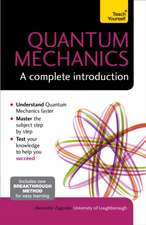Quantum Field Theory
Autor Mark Srednickien Limba Engleză Hardback – 24 ian 2007
Preț: 466.88 lei
Preț vechi: 507.48 lei
-8% Nou
Puncte Express: 700
Preț estimativ în valută:
89.37€ • 97.10$ • 75.12£
89.37€ • 97.10$ • 75.12£
Carte tipărită la comandă
Livrare economică 21 aprilie-05 mai
Preluare comenzi: 021 569.72.76
Specificații
ISBN-13: 9780521864497
ISBN-10: 0521864496
Pagini: 660
Ilustrații: 90 b/w illus. 250 exercises
Dimensiuni: 158 x 255 x 37 mm
Greutate: 1.18 kg
Editura: Cambridge University Press
Colecția Cambridge University Press
Locul publicării:Cambridge, United Kingdom
ISBN-10: 0521864496
Pagini: 660
Ilustrații: 90 b/w illus. 250 exercises
Dimensiuni: 158 x 255 x 37 mm
Greutate: 1.18 kg
Editura: Cambridge University Press
Colecția Cambridge University Press
Locul publicării:Cambridge, United Kingdom
Public țintă
Academic/professional/technical: Research and professionalCuprins
Preface for students; Preface for instructors; Acknowledgements; Part I. Spin Zero: 1. Attempts at relativistic quantum mechanics; 2. Lorentz invariance; 3. Canonical quantization of scalar fields; 4. The spin-statistics theorem; 5. The LSZ reduction formula; 6. Path integrals in quantum mechanics; 7. The path integral for the harmonic oscillator; 8. The path integral for free field theory; 9. The path integral for interacting field theory; 10. Scattering amplitudes and the Feynman rules; 11. Cross sections and decay rates; 12. Dimensional analysis with ?=c=1; 13. The Lehmann-Källén form; 14. Loop corrections to the propagator; 15. The one-loop correction in Lehmann-Källén form; 16. Loop corrections to the vertex; 17. Other 1PI vertices; 18. Higher-order corrections and renormalizability; 19. Perturbation theory to all orders; 20. Two-particle elastic scattering at one loop; 21. The quantum action; 22. Continuous symmetries and conserved currents; 23. Discrete symmetries: P, T, C, and Z; 24. Nonabelian symmetries; 25. Unstable particles and resonances; 26. Infrared divergences; 27. Other renormalization schemes; 28. The renormalization group; 29. Effective field theory; 30. Spontaneous symmetry breaking; 31. Broken symmetry and loop corrections; 32. Spontaneous breaking of continuous symmetries; Part II. Spin One Half: 33. Representations of the Lorentz Group; 34. Left- and right-handed spinor fields; 35. Manipulating spinor indices; 36. Lagrangians for spinor fields; 37. Canonical quantization of spinor fields I; 38. Spinor technology; 39. Canonical quantization of spinor fields II; 40. Parity, time reversal, and charge conjugation; 41. LSZ reduction for spin-one-half particles; 42. The free fermion propagator; 43. The path integral for fermion fields; 44. Formal development of fermionic path integrals; 45. The Feynman rules for Dirac fields; 46. Spin sums; 47. Gamma matrix technology; 48. Spin-averaged cross sections; 49. The Feynman rules for majorana fields; 50. Massless particles and spinor helicity; 51. Loop corrections in Yukawa theory; 52. Beta functions in Yukawa theory; 53. Functional determinants; Part III. Spin One: 54. Maxwell's equations; 55. Electrodynamics in coulomb gauge; 56. LSZ reduction for photons; 57. The path integral for photons; 58. Spinor electrodynamics; 59. Scattering in spinor electrodynamics; 60. Spinor helicity for spinor electrodynamics; 61. Scalar electrodynamics; 62. Loop corrections in spinor electrodynamics; 63. The vertex function in spinor electrodynamics; 64. The magnetic moment of the electron; 65. Loop corrections in scalar electrodynamics; 66. Beta functions in quantum electrodynamics; 67. Ward identities in quantum electrodynamics I; 68. Ward identities in quantum electrodynamics II; 69. Nonabelian gauge theory; 70. Group representations; 71. The path integral for nonabelian gauge theory; 72. The Feynman rules for nonabelian gauge theory; 73. The beta function for nonabelian gauge theory; 74. BRST symmetry; 75. Chiral gauge theories and anomalies; 76. Anomalies in global symmetries; 77. Anomalies and the path integral for fermions; 78. Background field gauge; 79. Gervais-Neveu gauge; 80. The Feynman rules for N x N matrix fields; 81. Scattering in quantum chromodynamics; 82. Wilson loops, lattice theory, and confinement; 83. Chiral symmetry breaking; 84. Spontaneous breaking of gauge symmetries; 85. Spontaneously broken abelian gauge theory; 86. Spontaneously broken nonabelian gauge theory; 87. The standard model: Gauge and Higgs sector; 88. The standard model: Lepton sector; 89. The standard model: Quark sector; 90. Electroweak interactions of hadrons; 91. Neutrino masses; 92. Solitons and monopoles; 93. Instantons and theta vacua; 94. Quarks and theta vacua; 95. Supersymmetry; 96. The minimal supersymmetric standard model; 97. Grand unification; Bibliography.
Recenzii
'This accessible and conceptually structured introduction to quantum field theory will be of value not only to beginning students but also to practicing physicists interested in learning or reviewing specific topics. The book is organized in a modular fashion, which makes it easy to extract the basic information relevant to the reader's area(s) of interest. The material is presented in an intuitively clear and informal style. Foundational topics such as path integrals and Lorentz representations are included early in the exposition, as appropriate for a modern course; later material includes a detailed description of the Standard Model and other advanced topics such as instantons, supersymmetry, and unification, which are essential knowledge for working particle physicists, but which are not treated in most other field theory texts.' Washington Taylor, Massachusetts Institute of Technology
'Over the years I have used parts of Srednicki's book to teach field theory to physics graduate students not specializing in particle physics. This is a vast subject, with many outstanding textbooks. Among these, Srednicki's stands out for its pedagogy. The subject is built logically, rather than historically. The exposition walks the line between getting the idea across and not shying away from a serious calculation. Path integrals enter early, and renormalization theory is pursued from the very start.... By the end of the course the student should understand both beta functions and the Standard Model, and be able to carry through a calculation when a perturbative calculation is called for.' Predrag Cvitanovi, Georgia Institute of Technology
'This book should become a favorite of quantum field theory students and instructors. The approach is systematic and comprehensive, but the friendly and encouraging voice of the author comes through loud and clear to make the subject feel accessible. Many interesting examples are worked out in pedagogical detail.' Ann Nelson, University of Washington
'I expect that this will be the textbook of choice for many quantum field theory courses. The presentation is straightforward and readable, with the author's easy-going 'voice' coming through in his writing. The organization into a large number of short chapters, with the prerequisites for each chapter clearly marked, makes the book flexible and easy to teach from or to read independently. A large and varied collection of special topics is available, depending on the interests of the instructor and the student.' Joseph Polchinski, University of California, Santa Barbara
'Over the years I have used parts of Srednicki's book to teach field theory to physics graduate students not specializing in particle physics. This is a vast subject, with many outstanding textbooks. Among these, Srednicki's stands out for its pedagogy. The subject is built logically, rather than historically. The exposition walks the line between getting the idea across and not shying away from a serious calculation. Path integrals enter early, and renormalization theory is pursued from the very start.... By the end of the course the student should understand both beta functions and the Standard Model, and be able to carry through a calculation when a perturbative calculation is called for.' Predrag Cvitanovi, Georgia Institute of Technology
'This book should become a favorite of quantum field theory students and instructors. The approach is systematic and comprehensive, but the friendly and encouraging voice of the author comes through loud and clear to make the subject feel accessible. Many interesting examples are worked out in pedagogical detail.' Ann Nelson, University of Washington
'I expect that this will be the textbook of choice for many quantum field theory courses. The presentation is straightforward and readable, with the author's easy-going 'voice' coming through in his writing. The organization into a large number of short chapters, with the prerequisites for each chapter clearly marked, makes the book flexible and easy to teach from or to read independently. A large and varied collection of special topics is available, depending on the interests of the instructor and the student.' Joseph Polchinski, University of California, Santa Barbara
Notă biografică
Descriere
Textbook on elementary particles for graduate students studying quantum field theory and elementary particle theory.
